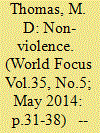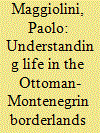| Srl | Item |
| 1 |
ID:
139606


|
|
|
|
|
| Summary/Abstract |
Bringing to light the first known Urdu primary source on Islam in colonial Burma, this essay examines the polemical encounter with Buddhism in the years surrounding the Third Anglo–Burmese War. Using the model of religious economy, the Urdu Sayr-e Barhma is contextualised amid the religious pluralisation and competition that accompanied colonisation as a multitude of religious ‘entrepreneurs’ and ‘firms’ rapidly entered the colony. Among them was the Indian Muslim author of Sayr-e Barhma, which provided a detailed account of the history, language and theology of Burman Buddhists and included an account of a public debate which, it claimed, culminated in the conversion of the Thathanabaing (Primate). Against the long-standing historiographical emphasis on the economic roots of anti-Indian sentiments in colonial Burma, this essay points to the religious dimensions of these enduring antagonisms.
|
|
|
|
|
|
|
|
|
|
|
|
|
|
|
|
| 2 |
ID:
130796


|
|
|
|
|
| Publication |
2014.
|
| Summary/Abstract |
Ethics and Indian civilization, political thought; global implication is a valid search into the global implications of the ethics grounded in the national ethos of the ideological, political, religious, social and cultural dimensions of the great civilization the word India stands for.
|
|
|
|
|
|
|
|
|
|
|
|
|
|
|
|
| 3 |
ID:
127650


|
|
|
|
|
| Publication |
2014.
|
| Summary/Abstract |
Despite much research work on the effect of social capital or the production of social capital along ethno-linguistic or racial dimensions, there is hardly any study in this line along the much fragmented character of Indian ethnicity. This article studies the impact of ethnicity along caste and religious dimensions on the growth of social capital in the Indian context. A simple theoretical model indicates that individual ethnicity formed out of individuals' separate pairwise connections with people, who are either of the same ethnic dimension or of different ethnic dimensions, is the only factor affecting endogenous social capital growth. Empirical results suggest that all forms of individual social capital are higher for people who are of the same caste or religion. It also shows that individuals' ethnicity with the same caste or religion is the only factor influencing high performance on the productivity of aggregate social capital in general and nonstructural form of social capital in particular.
|
|
|
|
|
|
|
|
|
|
|
|
|
|
|
|
| 4 |
ID:
128219


|
|
|
|
|
| Publication |
2014.
|
| Summary/Abstract |
The paper reconsiders the development of decentralization/centralization dynamics during the Ottoman Empire, focusing on the Ottoman-Montenegrin borderlands of Northern Albania with particular reference to the Mirdite territory inhabited by Catholic tribes. First, the paper describes the local socio-political system and balance of power in Mirdite territory before the enactment of the Gulhane decree. Secondly, the paper focuses on the developments and changes occurring in this land during the Tanzimat. Interaction, intertwining and overlapping between different strategies and policies are analysed in regard to the relationship between Catholic tribes, missionaries and Ottoman officials. Because of them, the changes and developments in the local administrative system occurring in both the religious and the political dimensions during the last part of the nineteenth century were expressions of the process of decentralization/centralization triggered by Istanbul from the third decade of the nineteenth century on.
|
|
|
|
|
|
|
|
|
|
|
|
|
|
|
|